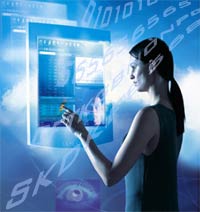AS 02-9 E
Atualizado dia 9/9/2016 2:14:48 PM em Almas Gêmeaspor Sergio Scabia
Reducing is applied to the main points of the Du Meridian and Pericardium Meridian of Hand Jueyin to calm the Heart, ease the mind, reduce heat and dissolve the Phlegm. Acupuncture Prescription:[ii] Dazhui (DU14), Fengfu (DU16), Shuigou (DU26), Neiguan (P6), Fenglong (S40) Supplementary Points: [iii] Mania with extreme heat: Prick the twelve Jing (Well) points on the hand (L11, H9, P9, LI1, SJ1, SI1) to bleeding for reducing heat. This is similar to the Ayurvedic Pancha Karma (The five treatment methods) concept of therapeutic bleeding to reduce Fire and Water element (Pitta) excess. Explanation:[iv] This condition is caused by the stagnation of Phlegm and Qi, which injures the Heart.
TCM Differential Diagnosis of Schizophrenia and Bi-Polar:
Manic psychosis (Flaring up of phlegm fire) "Loud"[v]“Sudden onset, irritability, easily angered, flushed face, blood-shot eyes, headache, insomnia followed by excessive motor activity and unusual strength, mania, restlessness, constantly abusive and violent behavior, climbing up to a high place and singing, running around with the body inappropriately exposed. Tongue: Red with yellow greasy coating. Pulse: Wiry, slippery and rapid pulse.” (Stone 97)
TCM, Western and Ayurvedic Manic Psychosis Treatment Principle: [vi]
For Manic Psychosis: Purge fire, remove phlegm tranquilizing the mind and calming the Shen.Ayurvedic Pitta Symptoms of Manic:
According to the 200 A.D. Sanskrit classic Sushruta Samhita, mania involves: “Excessive thirst, perspiration, burning sensation, voracious eating, insomnia, desire for shade, cold, wind and walks on the banks (of rivers or tanks), fits of anger, fancying fire in cold water and fancied sight of stars in the heavens in the day are the symptoms which characterize the Pittaja (Pitta) type.”[vii]
Western Drug Therapy
As a rule Western drug therapies mitigate symptoms, oftentimes without ameliorating the underlying ailment. We will now discuss the various drug therapies used by modern allopathic medicine along with the potentially safer herbs (certainly more widely time-tested - over several hundred to several thousand years) of Traditional Chinese Medicine and Ayurveda. One of the many problems with antidepressants, sedatives, and tranquilizers is that pregnant women taking them can cause the fetus to have hearing loss, abnormal limbs and even death.[viii] Most drug therapies work by adjusting the delicate neurotransmitter balance in the brain. “Our brains consist of about one billion neurons, all packed into the compact cranial case we carry around on our shoulders. These neurons communicate constantly with one another via electrochemical signals transmitted across their synapses by neurotransmitters.”[ix] “Neurotransmitters are nerve-signaling compounds released by individual nerve cells.”[x]
Nursing diagnoses: For the manic phase:
“Altered health maintenance; altered nutrition: less than body requirements; altered though processes; chronic low self-esteem; impaired home maintenance management; impaired physical mobility; impaired verbal communication; ineffective denial; ineffective individual coping; risk for violence: self-directed or directed at others; self-care deficit; sensory or perceptual alterations; sexual dysfunction; sleep pattern disturbance; social isolation.” (Eckman-97: 49)Nursing Interventions for the Manic Patient:
“Remember the manic patient’s physical needs. Encourage him to eat; he may jump up and walk around the room after every mouthful but will sit down again if you remind him. Offer high-calorie finger foods, sandwiches, and cheese and crackers to supplement his diet if he can’t remain seated long enough to complete a meal. Suggest short daytime naps, and help with personal hygiene. As the patient’s symptoms subside, encourage him to assume responsibility for personal care. Provide emotional support, maintain a calm environment, and set realistic goals for behavior. Provide diversional activities suited to a short attention span; firmly discourage the patient if he tries to overextend himself. When necessary, reorient the patient to reality, tactfully divert conversations when they become intimately involved with other patients or staff members. In a calm, clear, and self-confident manner, set limits for the manic patient’s demanding, hyperactive, manipulative, and acting-out behaviors. Setting limits lets the patient know that you’ll provide security and protection by refusing inappropriate and possibly harmful requests. Avoid leaving an opening for the patient to test or argue. Listen to requests attentively and with a neutral attitude, but avoid power struggles if the patient tries to put you on the spot for an immediate answer. Explain that you’ll seriously consider the request and will respond later. Collaborate with other staff members to provide consistent responses to the patient’s manipulations or acting out. Watch for early signs of frustration (when the patient’s anger escalates from verbal threats to hitting an object). Tell the patient firmly that threats and hitting are unacceptable and that these behaviors show that he needs help to control his behavior. Then tell him that the staff will help him move to a quiet area and will help him control his behavior so he won’t hurt himself or others. Staff members who have practiced as a team can work effectively to prevent acting-out behavior or to remove and confine the patient.” (Eckman-97: 49) “Alert the staff team promptly when acting out behavior escalates. It is safer to have help available before you need it than to try controlling an anxious or frightened patient by yourself. Once the incident is over and the patient is calm and in control, discuss his feelings with him and other suggestions to prevent recurrence.” (Eckman-97: 50)
[i] Cheng, Xinnong, ed., Chinese Acupuncture and Moxibustion, Beijing, China: Foreign Languages Press, 1987: p. 422.
[ii] Cheng, Xinnong, ed., Chinese Acupuncture and Moxibustion, Beijing, China: Foreign Languages Press, 1987: p. 422.
[iii] Cheng, Xinnong, ed., Chinese Acupuncture and Moxibustion, Beijing, China: Foreign Languages Press, 1987: p. 422.
[iv] Cheng, Xinnong, ed., Chinese Acupuncture and Moxibustion, Beijing, China: Foreign Languages Press, 1987: p. 422.
[v] Stone, A., "Acupuncture Treatments for Schizophrenia," 1997, Internet Source: https://www.acupuncture.com/Clinical/Schizo.htm
[vi] Stone, A., "Acupuncture Treatments for Schizophrenia," 1997, Internet Source: https://www.acupuncture.com/Clinical/Schizo.htm
[vii] Bhishagratna, K.L., trans., An English Translation of the Sushruta Samhita - Based on the original Sanskrit text - in three volumes, vol. III, Varanasi, India: Chowkhamba Sanskrit Series Office, 1991: p. 388.
[viii] Jolly, J., and Barg, M., The Secret of Life Study Guide, 2nd ed., New York: McGraw-Hill, 1995: p. 54.
[ix] Reid D. The Complete Book of Chinese Health and Healing, 1st ed. Boston, MA: Shambhala Publications, Inc., 1995: p. 400.
[x] Postlethwait, J.H.; and Hopson, J.L. The Nature of Life, 3rd ed. New York: McGraw-Hill, 1995: p. 679.
Visite o Site do autor e leia mais artigos.. Saiba mais sobre você! Descubra sobre Almas Gêmeas clicando aqui. |










